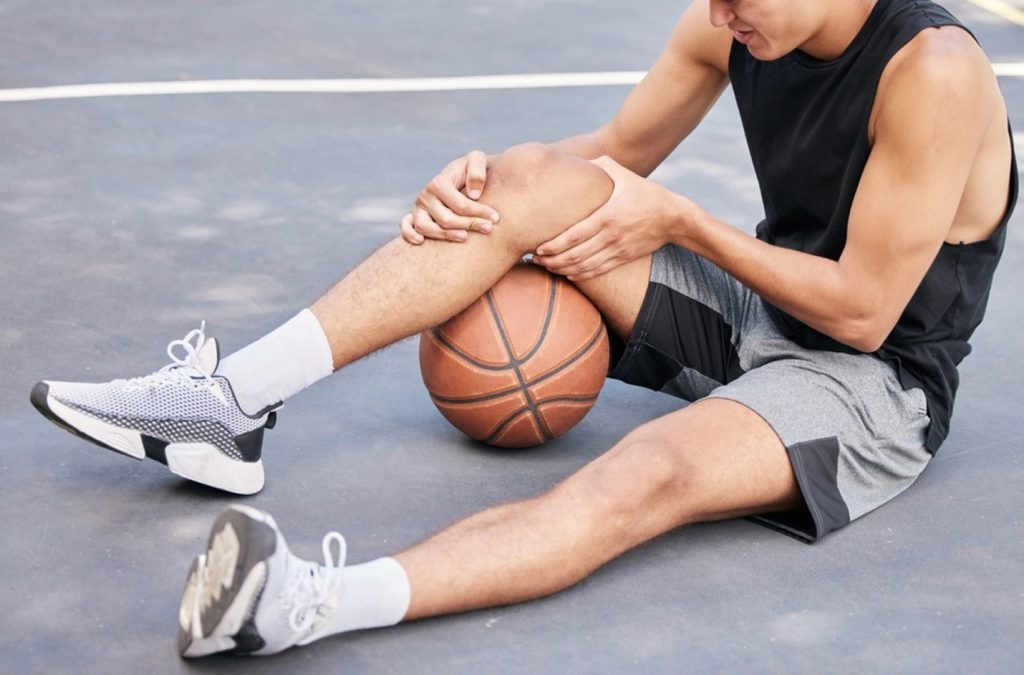
Basketball engages players in a high-intensity provoked contact game alongside other players, requiring them to sprint, jump, shift, and effortlessly change direction. Although basketball demands such explosive agility, it also makes players prone to suffering acute trauma, and overuse injuries to upper and lower limbs, and other dynamic joints.
Causes and Risk Factors
- Jumping and landing with poor technique
- Quick lateral movements and direction changes
- Player-to-player contact
- Overuse from year-round play
- Inadequate warm-up or poor conditioning
- Unsupportive footwear or hard playing surfaces
Common Injuries Due to Basketball
- Ankle Sprain
Definition: Stretching or tearing of the ankle ligaments, usually lateral.
Cause: Sudden twisting or sometimes rolling of the ankle during landing or direction changes.
Symptoms: Swelling, pain on weight-bearing, bruising, instability.
- Anterior Cruciate Ligament Tear
Definition: Partial or complete tear of the ACL in the knee.
Cause: Pivoting, sudden deceleration, or awkward landing from a jump.
Symptoms: Popping sensation, swelling, knee instability, pain during movement.
- Patellar Tendinopathy
Definition: Overuse injury of the patellar tendon connecting the kneecap to the shin.
Cause: Repeated jumping and landing motions.
Symptoms: Pain at the bottom of the kneecap, worsens with jumping or stairs.
- Meniscal Tear
Definition: Tear of the cartilage between the femur and tibia.
Cause: Twisting motion while bearing weight on the knee.
Symptoms: Knee locking, catching, swelling, or even pain during flexion.
- Finger Jam or Dislocation
Definition: Injury to the ligaments or joints of the finger.
Cause: Direct impact from the ball or contact with another player.
Symptoms: Swelling, limited motion, deformity (in dislocation), tenderness.
- Achilles Tendonitis or Rupture
Definition: Inflammation or tearing of the tendon connecting calf muscles to the heel.
Cause: Explosive jumping or sudden acceleration.
Symptoms: Heel pain, stiffness, swelling; in rupture, a sudden snap and inability to push off.
- Shoulder Strain or Dislocation
Definition: Overstretching or dislodging of the shoulder joint.
Cause: Falling on an outstretched arm or collision.
Symptoms: Shoulder pain, decreased range of motion, and visible deformity in dislocation.
- Shin Splints (Medial Tibial Stress Syndrome)
Definition: Inflammation of muscles around the shinbone.
Cause: Running on hard surfaces, improper shoes, overtraining.
Symptoms: Pain in tibia, especially during activity.
Diagnosis
- Clinical examination and history of injury
- Palpation and range of motion testing
- Functional assessment (e.g., gait, balance)
- Imaging: X-ray for fractures, MRI for soft tissue injuries
Treatment
- RICE protocol: Rest, Ice, Compression, Elevation
- NSAIDs for inflammation and pain
- Bracing or taping for joint support
- Physiotherapy for strengthening, mobility, and rehabilitation
- Gradual return to the play under medical supervision
Surgical management
- ACL rupture
- Full Achilles tear
- Severe meniscus injury
Prevention
- Warm-up and dynamic stretching before games
- Strength training for lower limbs and core
- Plyometric and proprioceptive exercises
- Proper landing techniques and flexibility training
- Wearing appropriate shoes with ankle support
- Avoiding overtraining and allowing rest days
- Using protective gear like knee or ankle braces when needed
Conclusion
The injuries are prevalent because of the fast-paced, contact nature of the sport. Appropriate footwear, strength training, and early detection of injuries alongside proper rehabilitation drastically reduce downtime and the risk of long-term issues.
For enquiries and online appointments, send a message to
www.DrAyyappanVNair.com/contact
For informative videos related to Shoulder problems and their treatment options, Sports Injuries and other orthopedic conditions, visit our YouTube channel Bangalore Shoulder Institute – https://www.youtube.com/@BangaloreShoulderInstitute

